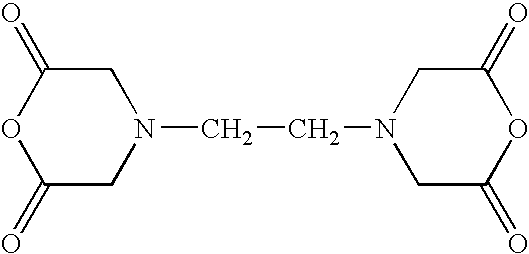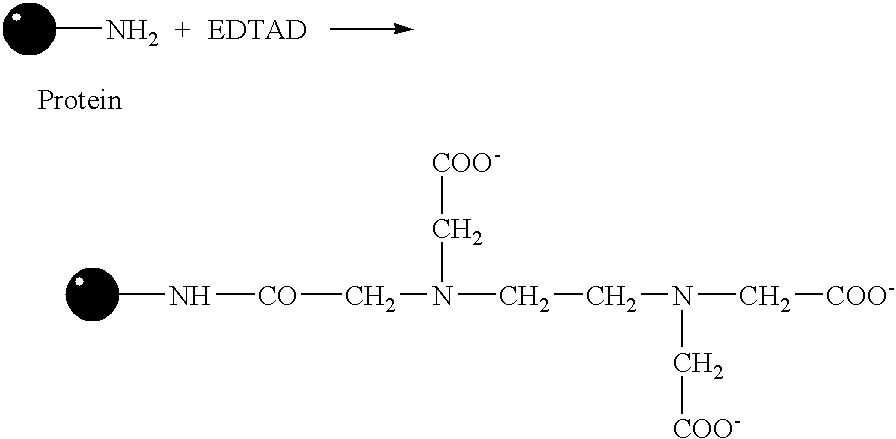Protein-polysaccharide hybrid hydrogels
a technology of polysaccharide and hybrid hydrogel, which is applied in the field of protein-polysaccharide hybrid hydrogel, can solve the problems of large use of non-biodegradable petroleum-based polymeric materials, large amount of space available, and health problems in humans and animals
- Summary
- Abstract
- Description
- Claims
- Application Information
AI Technical Summary
Benefits of technology
Problems solved by technology
Method used
Image
Examples
example 1
Protein-polysaccharide hybrid hydrogels according to the present invention were prepared as follows:
A-Type Gel: In the case of an A-Type hybrid gel, the pH of EDTAD-modified soy protein precipitate (prepared as described hereinabove) was carefully adjusted to pH 9.0 by drop-wise addition of 4N NaOH with continuous mixing. A 5% dispersion of CMC in water (commercial-grade and having a viscosity in the range of from about 3,000 to about 6,000 cp at 1%) was pre-equilibrated to form a transparent viscous gel. A calculated amount of this CMC gel was added to the EDTAD-modified protein gel so that the CMC-to-protein ratio in the mixture was from about 1:20 to about 1:10 (g / g). The protein concentration of the mixture was determined by the biuret method (Robinson, H. W. and C. G. Hogden (1940) J. Biol. Chem. 135:707) and adjusted to 12% (w / w) by adding the required amount of water. The mixture was then thoroughly blended using a kneading-type blender in order to completely mix the CMC into...
example 2
A soy protein solution (1,500 mL volume, 1.465% protein) was reacted with 3.3 g EDTAD under the conditions described above. The EDTA-modified protein dispersion (15% w / w) was thoroughly mixed with 1.1 g CMC pre-swollen in 30 mL water using a "POLYTRON"-brand homogenizer. The pH of the mixture was adjusted to 9.0. One (1) mL of 10% glutaraldehyde solution was added to the protein-CMC mixture and mixed well. The sample was cured overnight at room temperature, followed by ethanol treatment (.times.3). The sample was finally dried at 40.degree. C., ground with a mortar and pestle and sized to 350 to 750 microns using standard sieves.
example 3
One (1) kg of fresh carp fish was homogenized at pH 12 and left to stand for 20 to 30 min. The slurry was centrifuged at 10,000.times.g for 15 min. The supernatant was collected and adjusted to pH 4.6 to precipitate the protein. The slurry was centrifuged at 7,000.times.g for 10 min. The protein pellet was re-dispersed in water at pH 4.6 and then centrifuged at 7,000.times.g for 10 min. The protein pellet was collected and dissolved in water at pH 11.5 to a final concentration of 1.13%. A 4.5 L sample of this fish protein solution was reacted with 11.2 g of EDTAD at ambient temperature as described above. To a 15% dispersion of this modified protein was added 2.5 g CMC pre-swollen in 65 mL water and the resultant mixture thoroughly homogenized. The pH of the dispersion was adjusted to 9.0. The sample was cross-linked with glutaraldehyde at a glutaraldehyde to protein ratio of 1:200 w / w. The sample was cured overnight at room temperature, followed by ethanol treatment. The sample was...
PUM
| Property | Measurement | Unit |
|---|---|---|
| temperature | aaaaa | aaaaa |
| pH | aaaaa | aaaaa |
| pH | aaaaa | aaaaa |
Abstract
Description
Claims
Application Information
 Login to View More
Login to View More - R&D
- Intellectual Property
- Life Sciences
- Materials
- Tech Scout
- Unparalleled Data Quality
- Higher Quality Content
- 60% Fewer Hallucinations
Browse by: Latest US Patents, China's latest patents, Technical Efficacy Thesaurus, Application Domain, Technology Topic, Popular Technical Reports.
© 2025 PatSnap. All rights reserved.Legal|Privacy policy|Modern Slavery Act Transparency Statement|Sitemap|About US| Contact US: help@patsnap.com



